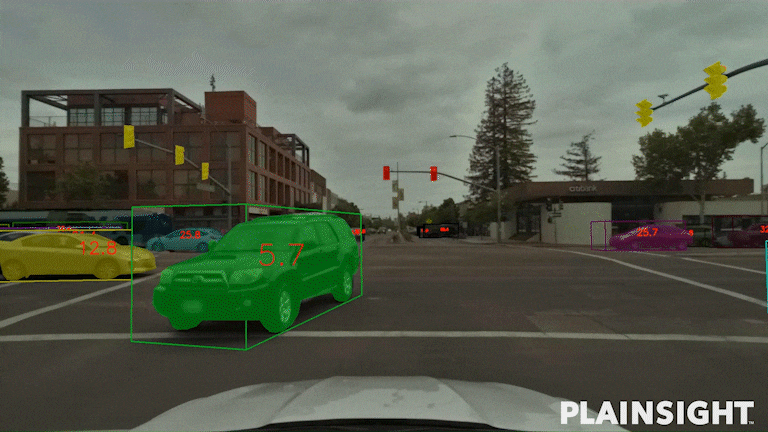Once the stuff of science fiction, self-driving vehicles are now merging onto roadways and into the news. Organizations ranging from car manufacturers to rideshare services to restaurants have launched ambitious initiatives and even started testing autonomous vehicles on select public roads.
According to CB Insights, funding in autonomous vehicle (AV) companies surpassed $12 billion in 2021, marking a more than 50% increase from 2020—and that’s just the beginning. Deloitte forecasts that by as soon as 2030, 12% of new car registrations globally are forecast to be autonomous vehicles.
So with all signs pointing to an increasingly driverless near-future, it’s important to understand the very real technology that’s turning AV science fiction into a reality.

How Do Autonomous Vehicles Work?
Computer vision is at the core of autonomous vehicle technology. Cars leverage object detection algorithms in combination with advanced cameras and sensors to analyze their surroundings in real time and recognize things like pedestrians, road signs, barriers, and other vehicles to safely navigate the road. Rapid advancements in vehicular cameras and vision AI have brought them closer than ever to meeting safety standards, earning public acceptance, and achieving commercial availability.
Levels of Vehicular Automation
When discussing self-driving vehicles and automated features (like cruise control, lane departure assistance, and emergency brakes), experts commonly use the SAE J3016. Developed by the Society of Automotive Engineers in 2014 (and updated in 2021), the SAE Levels of Automation scale creates a spectrum from zero to total automation:
Level 0: Automated warnings and temporary assistance like lane departure alerts and emergency braking.
Level 1: Steering or braking/acceleration support
Level 2: Steering and braking/acceleration support
Level 3 and 4: These features can operate the vehicles autonomously under specific conditions. Level 3 features could require the driver to take control of the vehicle.
Level 5: These features are the same as Level 4 features except they are capable of functioning in any road conditions.
Level 5 automation represents the standard that everyone in the race to mass produce self-driving cars is speeding toward. A Level 5 vehicle would operate with total autonomy, avoiding hazards to safely complete journeys without any driver input. Once manufacturers can attain this level of automation they’ll still have plenty of work ahead of them to ensure their vehicles can legally operate on public roads.

Notable Events and Milestones
1939: General Motors showcases theoretical self-driving cars as part of its famous Futurama exhibition at the World’s Fair in New York City.
1957: Researchers at RCA demonstrate a ‘self-driving’ car capable of navigating a 400-foot stretch of Nebraska highway with the help of detector circuits buried under the road.
1987: An autonomous Mercedes-Benz van developed by Munich-based researchers reaches speeds of nearly 60 miles per hour on empty streets.
1995: A team at Carnegie Mellon University completes a successful cross-country journey with Navlab. While the vehicle steers on its own, the brakes and accelerator are handled by a human operator.
2009: Google privately begins work on projects related to autonomous vehicles. In 2016, Google’s efforts led to the founding of Waymo. A fellow subsidiary of Alphabet, Waymo is now a leader in autonomous vehicles.
2010s: A range of major automobile manufacturers announce their intentions to begin developing autonomous vehicles, including GM, Ford, Toyota, BMW, and Volvo among many others.
2018: A woman in Arizona is struck by an Uber test vehicle. She is the first pedestrian to die as a result of an accident involving a self-driving car.
2020: The first regulations related to automated features in cars begin to appear.
2021: Tesla hosts its first AI Day, a conference for AI experts to get hands-on experience with evolving technologies like the company’s Tesla Bot, Cybertruck, and autonomous vehicles. The second-annual event is scheduled for this August.
What’s Keeping Autonomous Cars Off the Road?
Though ambitious partnerships and projects continue all the time, there are no autonomous cars available for consumers to purchase. A range of roadblocks are keeping self-driving cars mostly off of public streets:
- Accurate, real-time object detection is still challenging: Object detection models are typically trained using datasets of static images. There is a considerable learning curve when researchers attempt to introduce the same models to vehicle-generated video feeds and real-time imagery.
- Road conditions vary: The performance of a vehicle’s real-time object detection can vary greatly based on lighting and weather conditions. This necessitates huge, diverse datasets and resource-intensive data collection processes.
- Resource constraints remain: Though engineers continually make strides to improve both the accuracy and efficiency of object detection models, computational requirements for sophisticated models are still high enough to make autonomous vehicles expensive and resource-intensive.
- The public is understandably uneasy: Self-driving cars, trucks, and vans have made plenty of headlines over the past few years and a number have brought bad news. Autonomous vehicles are responsible for several deaths, so the companies racing to put these cars on the road will need to earn public trust.
- Regulations are inconsistent or non-existent: Autonomous vehicles are an emerging technology, with both corporate efforts and public perceptions evolving all the time. Regulations are in flux too. Those that currently exist have one thing in common – they fail to address every potential question and safety concern. Like the technologies they regulate, these laws and guidelines will need to change in the coming years.
In an April conversation with TED’s Chris Anderson, Tesla CEO Elon Musk suggested that he believes Tesla’s cars will achieve a suitable safety standard by the end of 2022. He acknowledges that this is an ambitious goal, noting that solving the problems associated with autonomous vehicles would amount to “solv[ing] real world AI.”
Put Plainsight Behind the Wheel of Your Computer Vision Project
The proven leaders in enterprise computer vision, Plainsight succeeds where other providers have failed. Request a call to learn more about how we could make computer vision a catalyst for your digital transformation.




